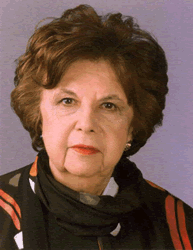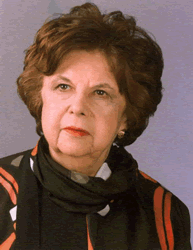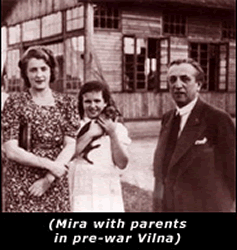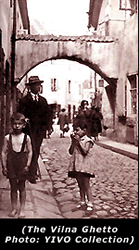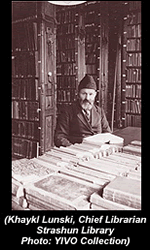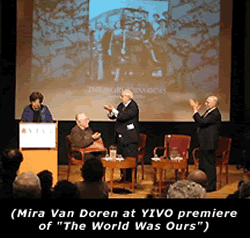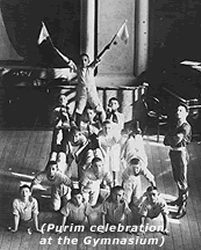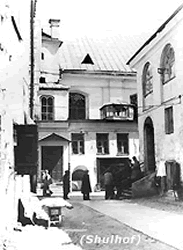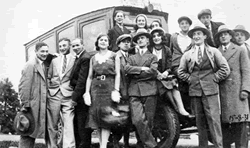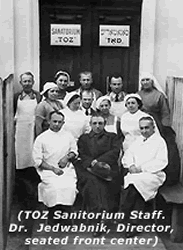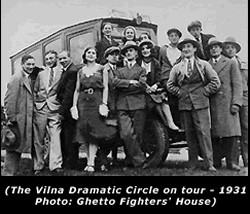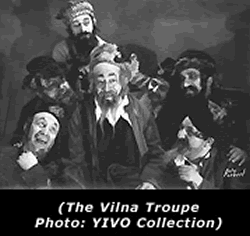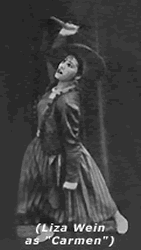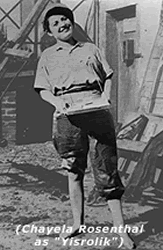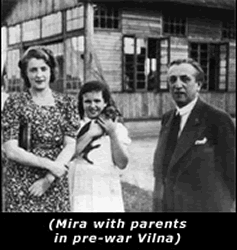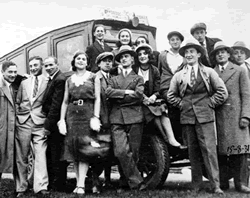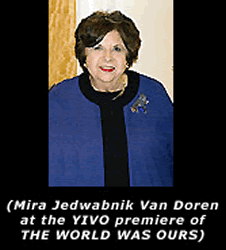Mira Jedwabnik Van Doren
was the guest of honor at YIVO's Second Annual International Women's
Division Luncheon. Held at the Center for Jewish History and entitled
"A Heritage Journey - Me'dor
Le'dor," the April 14th event was chaired by Fanya Gottesfeld Heller
and co-chaired by Cindy K. Stone and Jonathan I. Mishkin. Mira Jedwabnik
Van Doren, an artist and filmmaker whose work has been widely exhibited,
is working on the documentary entitled "Vilna: The Vanished City,"
which tells the story of the Jewish community that existed between the
two world wars. Jedwabnik Van Doren received the first Vilna Award.
A native of Vilna, she left with her parents in 1939 on the Stefan Batory,
the last ship out before the Second World War. Mira heads The Vilna
Project, Inc., and is dedicated to preserving and documenting the richness
and diversity of Jewish Vilna and to disseminating its cultural legacy.
CURRENT PROJECTS
The Vilna Project, Inc. is preparing an educational study guide to accompany the DVD of the film. A book which will complement the film "THE WORLD WAS OURS" is also being prepared. In addition, plans are underway for a DVD collection called "The Last Voices of Vilna" that will consist of the many valuable and inspiring interviews of Vilna survivors and scholars that could not be included in the documentary. We are currently seeking funds to complete these projects
The schedule for the film festival for the IAJGS conference in Chicago this
summer ( 2008) has been finalized and we will be screening two films of special
interest to Lithuanian researchers:
"The World Was Ours" - Monday, August 18th - 12:30PM - 2:00PM
Introduced by Howard Margol, President, Litvak SIG
This documentary film--dedicated to the memory of Jewish Vilna--draws on a
large collection of video interviews with dozens of survivors and scholars,
supplemented by archival photographs and footage, excerpts from diaries,
letters, poems, newspaper stories, and other contemporary accounts. A voice-
over narration by award-winning actor, Mandy Patinkin, weaves the many
elements into a single story. Archival music evokes the spirit of the times
and is supplemented by specially recorded performances in Yiddish, Polish
and other music popular in Vilna between the two World Wars. 58 min.
(About the filmmaker: Mira Jedwabnik Van Doren, founder of The Vilna Project,
was born in Wilno, Poland in 1929 to Dr. David Jedwabnik, a noted doctor,
and Lydia Baruchson Jedwabnik, a gifted artist. Six days before Hitler
marched into Poland (September 1, 1939), 10-year-old Mira sailed with her
parents to the United States to visit the New York World's Fair. Unable to
return home because of the outbreak of hostilities, she grew up in New York
City, studied at the High School of Music and Art, Queens College, Cranbrook
Art Academy, the Arts Students' League and Columbia University, earning a
degree in Fine Arts. In 1989 Ms. Van Doren formed a non-profit organization,
The Vilna Project, Inc., dedicated to preserving, documenting and
disseminating material evoking the richness and diversity of pre-war Vilna
(Wilno). She conducted extensive research toward depicting Jewish life in
the city, assembling more than 120 hours of interviews with survivors and
scholars in the United States and abroad, and collecting thousands of
photographs and other historic material.)
--
Director:
Mira Jedwabnik Van Doren
Writers:
Dina Potocki (writer)
Adam Van Doren (writer)
Genre:
Documentary
A documentary chronicling the rich, vibrant history of the Jewish community of Vilna (then Poland, now Lithuania,) known as "The Jerusalem of Lithuania", before its destruction in World War II. |
SYNOPSIS
Produced with careful attention to detail and historical accuracy, this one-hour documentary chronicles the rich, vibrant history of the Jewish community of Vilna, before its destruction in WWII.
The film focuses on the pre-war life of this vibrant culture depicting its hopes, dreams and remarkable achievements, a cultural atmosphere producing illustrious figures like: Chaim Soutine, Jacques Lipchitz, Jascha Heifetz, Nadia Reisenberg, Avram Sutzkever, Chaim Grade, Joseph Buloff, The Vilna Troupe, naming just a few.
The community's dedication to culture and education was so strong that, during the Holocaust, its people risked their lives to save precious books and documents marked for destruction by the Nazis. Locked in the ghetto, fully aware of their imminent annihilation, they continued to present concerts, theatre and art exhibitions. This film tells their story.
, be
fore its destruction in WWII
Mira Jedwabnik Van Doren
The Vilna project/ A Lost People Remembered
By: Kathryn Boughton
04/03/2008
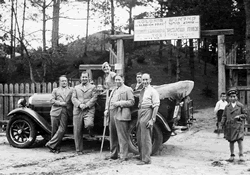
A 1931 photograph of the group called the Vilna Dramatics
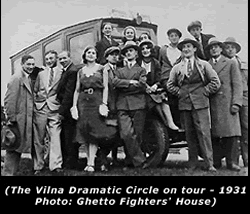
www.thevilnaproject.org/film.html
They are virtually all gone-70,000 Jews from Vilna, Poland, annihilated in the Holocaust, the few aged survivors now inevitably exiting life's stage. But the Jews of Vilna will live on through the efforts of one woman, Mira Jedwabnik Van Doren of Cornwall and New York, who returned to her native land 60 years after her precipitous departure, determined to record the memories of fellow survivors and tell the story of the rich culture that had informed her youth.
Mira and family as a child in Vilna
Mrs. Van Doren has created an hour-long documentary, "The World Was Ours," which will air Wednesday at 8 p.m. on CPTV. It will repeat on April 11 at 11 p.m.
"I felt I had to tell the story of these people who can never tell of themselves," said Mrs. Van Doren as she sat before the warm hearth in her Cornwall living room. "I just wanted to show respect for them-for their living and their dying. They had hopes and dreams, loves and hates, and they were wiped out. There was a time, there was a community, there was a city, and the only way that it will continue is in my story."
Mrs. Van Doren, an only child, left Vilna in late August 1939, scion of the last Jewish family to gain a safe exodus. Pulling her 69-year-old travel documents from a file, she points to the date on the bottom, Sept. 1, 1939, the very day the war began.
As she tells it, the family's departure was almost accidental. Her father, a prominent physician, decided on a whim that he would take the family to the World's Fair in New York. "My father had just published a book and he was in Warsaw for a book-signing. On a lark, he thought we should take a vacation to see the World's Fair."
Dr. Jedwabnik approached the U.S. consulate in Warsaw, applied for the necessary papers, and plans were laid to sail from France in August aboard the Normandy.
Mrs. Van Doren said her father "wasn't an innocent," but that in their enlightened little Polish city he had been isolated from the brewing threat in Western Europe. In Paris during that summer of 1939, "he was told he was a damned fool; didn't he know there was going to be a war?" Mrs. Van Doren recalled. "They said, 'What are you doing out there? Smelling the wind?'"
Perhaps alarmed by what he had heard, Dr. Jedwabnik rethought his original plans to take his family across Europe to depart from France. The family had always protected its young daughter from anti-Semitism, and her parents may have chosen not to alarm the little girl even now. Ostensibly without motive, the doctor made an abrupt decision to leave from a Polish port.
Luckily, the travel agency he called had just received a cancellation for a cabin for three and he quickly booked it. Apparently reflecting a feeling prevalent in the city that common sense would ultimately prevail, the little family left on Aug. 22 with no idea that they would never see the pre-war city, their friends or their family again. "I didn't even have a winter coat," Mrs. Van Doren recalled. "My mother liked to travel light and she said, 'Who needs a coat in New York in September and October?'"
But there were ominous signs of conflict ahead, even as they took the overnight train north to the seaport. Mrs. Van Doren remembers seeing soldiers at rail stations saying goodbye to their loved ones. "It scared me when I peered out the windows of the train," she remembered.
At the port, a friendly steward who had served them on a previous cruise told her father that doctors were being detained. The physician covered his title with his thumb when presenting his passport and succeeded in getting a stamped boarding pass. He told his wife and daughter to get on board and to stay there no matter what happened. They watched from the deck as the same steward found him in the crowd and escorted him on board through the kitchen.
"I was told we were the last Jewish family to leave," she said.
Mrs. Van Doren is well aware of their extraordinary luck. "It was as if my life stopped in 1939 and another started in 1939," she said. "In a way, I was distant from what happened to the people who stayed behind. I went to school, I lived with my family, I ate my sandwich for lunch. And for a long time we received letters-my father even had his fur-lined coat sent to this country by his mother. No one imagined the disaster that was to come."
But disaster did come and the losses were registered in the United States, thousands of miles away. Mrs. Van Doren has never been able to discover the fate of family members that disappeared in the Holocaust, but she has heard stories from the few friends who did survive and is well aware of her phenomenal luck. She said she woke up one day in the early 1990s, after a life filled with artistic successes, amid the security of her family, and thought, "Lady, you don't get it for nothing. You didn't get on that ship; you didn't get all your good luck without an obligation."
That obligation was to recreate, for the world to know and remember, the vibrant intellectual, artistic and social life she had known in her youth. Mrs. Van Doren is a well-known artist but had no experience in filmmaking when she was inspired to commemorate the lost life of her lovely city. She was undeterred by her lack of knowledge, however.
"I am a project person," she said. "I get ideas and I really believe in them and think I should do them. One day I thought I should do a documentary about Vilna, which was insane because I had never made a film. But I was never discouraged," she said. "I thought I would just start and go step by step.
"At first I did a lot of reading because I was only a child when I left Vilna. I did not know the city the way the older people had. I wrote all over the world for materials and did a lot of research. I started interviewing people. I knew I had a serious obligation."
Helping her to recapture that world was a small circle of Vilna survivors who had immigrated to the United States following World War II-only about 1,200 survived the war out of the more than 70,000 crowded into the city in 1939. She said these survivors had sought each other out upon arrival in their new home. "My father headed an organization that helped survivors," she said. "We would hear this one survived or that one survived. People searched."
"With luck I got a film editor who was wonderful and who spoke Polish, English and Yiddish," she continued.
Yiddish was a particularly important component because in the decades just before World War II the Jewish community of Vilna had blossomed, transforming the city into center for Yiddish culture. The city had a Yiddish newspapers, Yiddish theaters, schools, literature and social organizations. "Yiddish was the language of the Jews of Vilna and they were extraordinarily proud of it," Mrs. Van Doren reported. "If they had continued, it would have been a much more serious language than a folk language. It is a combination [of German, Russian, Lithuanian and Polish] and it is a very rich language, but it is often associated with poverty, with immigrants, with foreigners. In Vilna, middle-class Jews and intellectuals were proud to speak it. They even performed Shakespeare and Chekov in the theaters, all translated into Yiddish."
She said there is a common misconception about Eastern European Jewry that the people lived deprived lives, in shtetles that everyone wanted to leave. "When I used to hear people talking about the Jews of Vilna they were not talking about the city I lived in," she said. "I lived in a sophisticated, serious, creative socially alive community, a city of wonderful parks, theaters and art-an exciting world, a proud Jewish world. I believed anything was possible-and I was not unique. We were middle-class professionals, but the Jewish arts didn't come from the middle class. The poets were all poor Jewish kids."
She remembers the sounds and the sights of her childhood home. "The architecture was Baroque and Italian Renaissance," she relates. "It had a university and was not an industrial city, so there was no noise. You could hear things-the sound of horse hooves on the cobble streets, of people talking on the street in many languages. We had wonderful trees and parks ... ."
It was the sights and sounds of this long-ago world that she wanted to recapture in her documentary. "The city still exists, but no more the life," she said sadly. "Another group of Jews now lives there, but not the Vilna Jews with the traditions, the loves, the hates ... I wanted to get the sounds of the city, the sounds of Jewish Vilna. All the survivors say that I was able to recreate that life."
Production of the documentary went on sporadically over a decade and a half, and Mrs. Van Doren praises her sons, Adam and Daniel, and her husband, John Van Doren, for helping her to finish it.
"I might have given up without the support of my family," she said, adding that Daniel and his wife had accompanied her to Vilna in 1993 for the 50th anniversary of the liquidation of the Jewish quarter. Her family helped her to secure grants and patiently read and reviewed the materials she produced.
Later, her son Adam, who had made three previous films about James Thurber, Harold Ross of The New Yorker and his own grandfather, Mark Van Doren, became her producer. Working with editor Dina Potocki and narrator Mandy Patinkin, they began to put the final product together.
"We worked seven days a week for seven months," Mrs. Van Doren related. "The three of us put it together. We had a good script and then we made it tighter, made a better story. And I was incredibly lucky to get Mandy Patinkin as the narrator."
"It was more work than I could have imagined, but once I made the commitment, there was no way I could stop," she concluded.
With the film completed and ready to be broadcast, she feels there is still more to be done. "We had maybe 70 hours of interviews that we had to edit down to four or five minutes," she said. "We had to keep the documentary to 58 minutes, and I wanted to present a story based on ideas. Now I would like to do another film, 'The Last Voices of Vilna' with maybe 10 hours of those interviews. ..."
Still, having achieved her first goal fills her with pride because she believes she has created a lasting memorial to a way of life that was cruelly cut short. "My greatest reward is that more than 100 [PBS] stations will show my documentary," she said. "That is 60 million households that will learn about Vilna-and all because I had to tell this story."
For a contribution of $65, you will receive, as a gift, a DVD or VHS the documentary film "THE WORLD WAS OURS" . If for some reason the DVD or VHS should arrive defective, please return it to The Vilna Project, Inc and they will replace it. You will receive an acknowledgement for your contribution
For any information about the Vilna Project, Inc. or the documentary film, you may contact them at :
The Vilna Project, Inc.
130 West 57th Street
New York, NY 10019
Office Tel: 212-245-7493
Email: thevilnaproject@gmail.com
Produced with careful attention to detail and historical accuracy, this one-hour documentary chronicles the rich, vibrant history of the Jewish community of Vilna, before its destruction in WWII.
The film focuses on the pre-war life of this vibrant culture depicting its hopes, dreams and remarkable achievements, a cultural atmosphere producing illustrious figures like: Chaim Soutine, Jacques Lipchitz, Jascha Heifetz, Nadia Reisenberg, Avram Sutzkever, Chaim Grade, Joseph Buloff, The Vilna Troupe, naming just a few.
The community's dedication to culture and education was so strong that, during the Holocaust, its people risked their lives to save precious books and documents marked for destruction by the Nazis. Locked in the ghetto, fully aware of their imminent annihilation, they continued to present concerts, theatre and art exhibitions. This film tells their story.The Vhttphttp://www.thevilnaproject.org/contact.html
New York, NY 10019
Mira Van Doren at the YIVO premiîere
To read about Mira and her family go to;
